

Les bonnes manières à table en Corée. Aubergines vapeur au gochujang (Corée) Banchan d'anchois. [Photographs: Vicky Wasik] Myeolchi bokkeum is a classic Korean banchan consisting of stir-fried dried baby anchovies coated in a sweet-spicy-savory glaze.
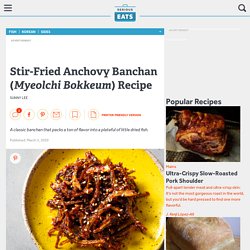
Served at cool room temperature, this side dish is light and refreshing, perfect alongside spicy Korean barbecue, hot and cheesy fire chicken, a hearty bossam spread, or as part of any simple weeknight dinner. (It's also a very good snack for any time of day.) Bibimbap. See Full Nutritional GuidelinesHide Full Nutritional Guidelines (Nutrition information is calculated using an ingredient database and should be considered an estimate.)
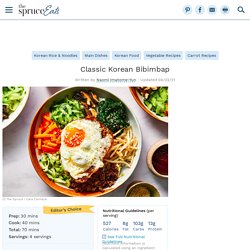
Use this recipe to make arguably the best known Korean dish around the world: bibimbap. What makes this meal stand out? Not only is it a Korean classic, but it's also delicious, gorgeous on the plate, and easily tweaked for different palates and spice levels. That means if you're a typical American or Westerner who can't handle foods that are extremely spicy, homemade bibimbap is the dish for you since you can easily lower the spice load. Bœuf à la coréenne. Boeuf Bulgogi. Boeuf haché bulgogi. Bossam : bouchées de poitrine de porc. These deeply savory Korean pork belly lettuce wraps walk a fine line between a light meal and and indulgent feast —a line you may not have known existed until now.
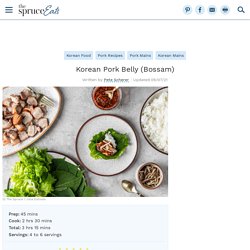
The unctuous, fatty pork is a rich treat for any meat lover, while the crisp lettuce, pickled radish, and sweet rice bring balance and a sense of brightness. The best way to serve these is family style so that diners can assemble their own wraps according to their tastes: putting rice in the wrap or enjoying it on the side, using more sauce or less, or doubling down on the spicy pickled radishes. That said, rice in the wrap, a light drizzle of the intensely savory sauce and three or four slices of radish is just about perfect, like a tiny Korean taco. Though these take some time to prepare, if you make the meat and pickles ahead of time, and store them in the refrigerator, the wraps can come together very quickly for an easy weeknight meal.
Calamars grillés à la coréenne. Chou chinois fermenté. This pickled and fermented Napa cabbage is the most popular and recognizable form of kimchi.
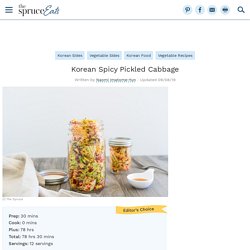
Baechu kimchi is not only good as a side dish to almost every Korean meal, but it is also the foundation for many soups, stews, stir-fries, and rice dishes. 10 cups of water 2 Napa cabbages (washed and cut into 2-inch squares) 1 cup coarse salt (or kosher or sea salt) 1 tablespoon garlic (finely chopped) 1 tablespoon ginger (chopped) 1/2 cup kochukaru 2 tablespoons sugar 5 scallions (cut into 1/2-inch pieces) Optional: fish sauce Gather the ingredients. In a large nonreactive bowl or pot, mix salt into the water. Courgettes frites à la coréenne (Hobak Jun) See Full Nutritional GuidelinesHide Full Nutritional Guidelines (Nutrition information is calculated using an ingredient database and should be considered an estimate.)
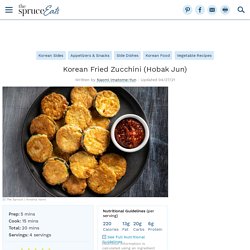
A delicious Korean side dish, fried zucchini (known as Hobak Jun or Jeon) is easy to prepare. As a bonus, it goes well with almost every Korean meal. Epinards à la coréenne. See Full Nutritional GuidelinesHide Full Nutritional Guidelines (Nutrition information is calculated using an ingredient database and should be considered an estimate.)
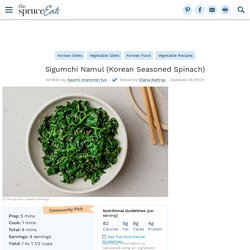
Appetizers and side dishes play a key role in Korean cuisine, and sigumchi namul (seasoned spinach) has everything you need to make a particular tasty side. To make this popular Korean side dish (banchan), fresh spinach is blanched and seasoned with soy sauce, sesame oil, sesame seeds, sesame salt/gomasio, and garlic with a touch of sugar. Flan salé aux oeufs (Gaeran Jim) See Full Nutritional GuidelinesHide Full Nutritional Guidelines (Nutrition information is calculated using an ingredient database and should be considered an estimate.)
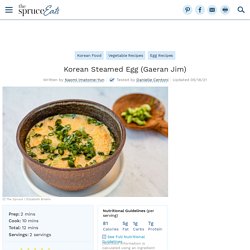
Korean steamed eggs (gaeran jim) have a bit in common with an omelet, poached eggs, and scrambled eggs. Galbi Jim (boeuf braisé coréen) Gao bao coréen au poulet croustillant. Gimbap coréen à l'omelette et au poulet. Jap Chae : nouilles sautées aux légumes. See Full Nutritional GuidelinesHide Full Nutritional Guidelines (Nutrition information is calculated using an ingredient database and should be considered an estimate.)
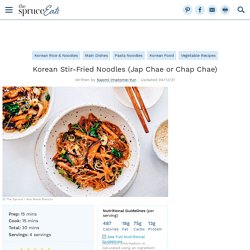
Korean stir-fried noodles (chap chae or jap chae) is one of the most popular noodle dishes in Korea, and also seems to be the one that Westerners like best. The foundation of the dish is Korean glass noodles, which can be made from mung bean or sweet potatoes. Mandu (raviolis coréens) See Full Nutritional GuidelinesHide Full Nutritional Guidelines (Nutrition information is calculated using an ingredient database and should be considered an estimate.)
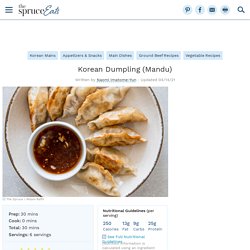
Korean dumplings, known as mandu or mandoo, are a traditional food that's easy to make. These tasty little dumplings are stuffed with a mixture of meat and/or vegetables, and there are almost as many variations of mandoo as there are cooks in Korea. Nouilles coréennes à la pâte de soja noire. See Full Nutritional GuidelinesHide Full Nutritional Guidelines (Nutrition information is calculated using an ingredient database and should be considered an estimate.)
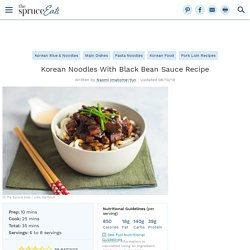
Jajangmyun (Chajangmyun, Jjajang myun) is one of the most popular noodle dishes in Korea, even though it actually originated in China, not Korea. It is the Korean adaptation of a Chinese black bean noodle dish with the same name, and you can find it in many restaurants in Korea. Pa Jun (crêpes coréennes aux ciboules) See Full Nutritional GuidelinesHide Full Nutritional Guidelines (Nutrition information is calculated using an ingredient database and should be considered an estimate.) A Korean scallion pancake is called pa jun (or pajeon). Poissons entiers frits. See Full Nutritional GuidelinesHide Full Nutritional Guidelines (Nutrition information is calculated using an ingredient database and should be considered an estimate.)
Eating the whole fish, usually yellow croaker, is common in Korea, whether it's seasoned and braised, cut up and made into a stew, or fried on the stove. Nose-to-tail fish eating is healthy and reduces waste since you can eat everything—the skin, the head, the tail, and the fins. One of the most delicious parts of a fish is on the back part of the head, which is lost if you fillet a fish.
Porc façon barbecue coréen (Toejigogi Kui) Poulet frit à la coréenne. Poulet frit à la coréenne, sauce aigre-douce épicée. Ragoût au kimchi. See Full Nutritional GuidelinesHide Full Nutritional Guidelines (Nutrition information is calculated using an ingredient database and should be considered an estimate.) Korea’s national dish, kimchi, is a spicy, pickled cabbage that is served as a condiment with almost every meal.
Riz aux patates douces à la coréenne (Gogumabap) Sookju Namul : germes de soja en salade. See Full Nutritional GuidelinesHide Full Nutritional Guidelines (Nutrition information is calculated using an ingredient database and should be considered an estimate.) Sookju namul, or Korean mung bean sprout salad, is one of the most popular side dishes you're likely to find in Korea. Soupe au poisson séché (Bugo Guk) Soupe coréenne au chou. Soupe coréenne au radis blanc et au boeuf (sogogi muguk) Vinaigrette au gochujang. Gather the ingredients. In a small bowl, add all of the ingredients.
Whisk until well combined. Store in an airtight container in the refrigerator for up to two weeks. Chili Peppers Fight Inflammation. Yukaejang : soupe épicée à l'effiloché de boeuf. Bungeo-Ppang (Corée) Gingembre confit au miel à la coréenne. Pancakes coréens aux fleurs (hwajeon) Thé au ginseng. Thé au yuzu. Tranches de coing confites à la cannelle (Corée) Yakgwa (gâteaux au miel) Hotteok - Pancakes aux fruits secs (Corée)